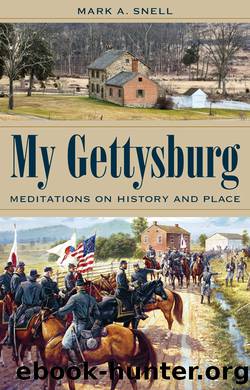My Gettysburg by Snell Mark A.;

Author:Snell, Mark A.;
Language: eng
Format: epub
Publisher: The Kent State University Press
The refrain, however, used a good deal of poetic license. Jenny was not laid to rest in a âchurch-yardââshe was buried in Evergreen Cemeteryânor did willows grow over her grave.
Although the Battle of Gettysburg had caused the death of one young woman and thousands of young men, the passing of one particular Union soldier became a cause célèbre across the North. During the afternoon of July 1, two corps of the Army of the Potomacâthe First and the Eleventhâwere beginning to retreat under the weight of an overwhelming Confederate assault. Two divisions of the Eleventh Corps were heading back toward Cemetery Hill, where a third division already was digging defensive positions. Sensing that the rest of his corps needed help, the Union division commander on Cemetery Hill sent one of his brigades to the other side of Gettysburg to fight a delaying action while the rest of the corps escaped. This lone brigade quickly was overrun and soon was flying rearward to Cemetery Hill. One soldier from that brigade, a member of the 154th New York Infantry, was shot during the retreat and lay mortally wounded. Before he died, he pulled out a photograph of his children for one last look. When he was found several days later, his lifeless hands still clutched the photograph next to his heart. One recent historian has written: âHe was only one of thousands of dead men strewn about Gettysburgâs fields, but he was special. Of all the blackened, bloated, contorted corpses on the battleground, his death pose spoke of devotion. In the silence of death, he spoke of love.â10
Unfortunately, the soldier bore no identification. The story was so touching that the childrenâs image was reproduced all across the northern states, and newspaper editors published the moving account time and again. Wilson Horner, the director of the National Union Musical Association of Baltimore, composed the music for a song written by W. H. Hayward, titled âThe Unknown Soldier Song (Who Is He?).â Published in 1864, it was dedicated to âthe orphans of the brave soldiers who have fallen in defence of their country.â Its six verses spoke of duty to country, love of flag and family, and the plight of the poor widow and children. Eventually, a woman living in western New York discovered that the celebrated photograph was the same one she had given her husband, Sgt. Amos Humiston. By the time Horner published âThe Unknown Soldier,â Humistonâs identity already had been ascertained.11
The story of the nameless soldier touched everyoneâs heart, including a composer named James G. Clark, who had made a name for himself as a popular songwriter and performer during the antebellum period. Clark had entered a contest sponsored by the American Presbyterian newspaper to compose song lyrics concerning the Humiston incident. Announcing Clark as the winner, the paper proclaimed, âOut of several pieces sent to us on the death of Sergeant Humiston, we unhesitatingly give the preference to the following simple, sweet verses, very well adapted to music, which the author has already provided for them, and will soon publish.
Download
This site does not store any files on its server. We only index and link to content provided by other sites. Please contact the content providers to delete copyright contents if any and email us, we'll remove relevant links or contents immediately.
| United States | Abolition |
| Campaigns & Battlefields | Confederacy |
| Naval Operations | Regimental Histories |
| Women |
In Cold Blood by Truman Capote(3306)
The Innovators: How a Group of Hackers, Geniuses, and Geeks Created the Digital Revolution by Walter Isaacson(2832)
Steve Jobs by Walter Isaacson(2831)
All the President's Men by Carl Bernstein & Bob Woodward(2327)
Lonely Planet New York City by Lonely Planet(2171)
And the Band Played On by Randy Shilts(2127)
The Room Where It Happened by John Bolton;(2102)
The Poisoner's Handbook by Deborah Blum(2089)
The Murder of Marilyn Monroe by Jay Margolis(2057)
The Innovators by Walter Isaacson(2055)
Lincoln by David Herbert Donald(1943)
A Colony in a Nation by Chris Hayes(1880)
Under the Banner of Heaven: A Story of Violent Faith by Jon Krakauer(1746)
Amelia Earhart by Doris L. Rich(1647)
The Unsettlers by Mark Sundeen(1643)
Birdmen by Lawrence Goldstone(1618)
Being George Washington by Beck Glenn(1612)
Dirt by Bill Buford(1610)
Zeitoun by Dave Eggers(1590)
